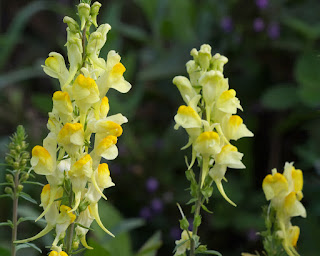A name, as the aphorism implies, carries with it a whole baggage train of associations. These associations, both positive and negative, profoundly influence how we look at an object, our attitude towards it, and, more fundamentally, whether we notice it at all. Here are a couple of examples from plants found in the park.
 |
| By Fen Road Exit - 19 May 2015 |
Commonly called cow parsley. Cow has connotations of a dim, lumbering beast. It is also a derogatory term for a woman. By implication, this plant is not a fine beauty or worthy of much attention.
It is also called Queen Anne's lace. Now it is regal and associated with the fine and delicate material. I don't know for certain, but I would hazard a guess which name is used when this plant is in a Chelsea show garden. I certainly looked at, and photographed, Queen Anne's lace.
 |
| Wetlands - 6 June 2015 |
The dog daisy. Not a plant to be admired and only fit for the dogs. A plant I can't help but apologise for liking.
As ox-eye daisy, it is far more romantic conjuring up images of dewy eye Jersey cows looking dolefully over field gates in pastoral Devon.
If it is the exotic you are looking for, look no further: L.vulgare is the moon daisy. With a name like that, who wouldn't go out of their way to find it? I did and I found it here in Milton Country Park!
All Anglo Saxon
I have been very careful throughout this blog to use traditional anglo-saxon names for the plants that I feature. This is for two reasons: firstly, because I think that the use of the latin name implies a degree of accuracy of identification that I do not want to claim; and, secondly, because traditional names sound as if they have some deep romantic meaning rooted in English folklore.I have been doing some research into the origins of the names of some of the flowers found in the park.
 |
| South of Park - 23 August 2015 |
Here is a surprise. I expected the name to be associated with its irritating sting. But it is not. Instead, the name is derived from a word meaning to sew. It is a plant from which fibres were once made and used for sewing.
 |
| Orchard - 22 August 2015 |
Again, I was totally wrong in my assumption that the name was somehow associated with the vile smell of the leaves when they are bruised. The reference gives two possible derivations: hoary honey or a corruption of the latin Urinaria as the plant was used to treat strangury and dysuria. And the black? Because it has dark flowers.
 |
| Orchard - 19 August 2015 |
Finally, and most whimsically, toadflax, so named because of the alleged similarily of the flower to a little toad. Alternatively, because toads were said to shelter beneath the plant.
More prosaically, the flax part of the name is derived from the shape of the leaves resembling those of flax.
Queen Anne's lace
The derivation of this name is worthy of mention. The story goes that Queen Anne was touring the countryside, visiting her subjects, when she saw these flowers lining the roadside. Mistakenly, she believed that the locals had draped lace over the road verges to welcome her. Hence the name.
As a child I knew this flower as keck (used entirely in a derogatory fashion). This name apparently comes from an old English work 'keek' meaning to peep or to spy, and relates to fact that one can look through the hollow stems of the plant.
--------------------------------
This shows that it is all too easy to overlook the interest and the beauty in the plants around us simply because of the names we give them. It is also certain that I will never look at any of the plants mentioned in this post the same again, now I know something of the origins of the names I use for them.
Next: Meadow Flowers
No comments:
Post a Comment